Giovanni Rossi ,
Thanks for your input and sorry for the late reply. I've been crazy buzy with work and tried to put every spare hour into the oven. Indeed I was wondering about the thickness difference between the bricks. It seems to be in the 1,5-3mm range. To prevent tolerance stackups going out of control I've gone and selected them to low, medium and high bricks, and made sure not too stack extremes on top of each other and indeed now on the 3rd row it nicely evens out. I'll bring the leveling laser in for the next round to see if I'm out of level, but eyeballing it so far it looks pretty good.
It's been slow going here, but now I've finally laid the first three courses in the mud it does feel 'real'. Learnings so far:
- It's quite a bit of jiggling with brick drying time after submersion & homebrew water amount. For normal bricks the recommendation was to soak and afterwards leave to rest for 24h, but that's way too much for my firebricks. Leaving them at rest for 2-3hrs seems more ideal. Otherwise I feel they immediately suck all the water, and therefore 'flow', out of the mud. Ie: it's impossible to bed the bricks down if they (and the mortar) are not on the wet side as compared to 'normal' bricks and mud. I think my first course was too dry, the second one was ok, and the third one slightly too wet, so probably I've now found a sweet spot.... until the angle gets too large and bricks start slipping

- The amount of 'overhead' that I'm going through now as compared to laying the bricks is quite high: sieving the ingredients of the mortar, cutting and selecting the bricks, detailing and cutting the arch bricks. It's slightly getting to me, but in the end it's a hobby project, so I'm just taking my time and enjoying the result. But for the people considering between a kit and the homebrew approach: definitely something to think about
- I've not fitted my IT with a clamp yet, so far it's working quite well without, after getting used to it.
In the attachment some pictures of the current status.
I do have some questions about the bricklaying, hopefully you guys can shed some light on it. See especially the 2nd and 3rd pictures:
To be able to bed the bricks down I'm trying to not put too much mortar under them. I also 'butter' them with a slight layer on the side, and then bed them down. This results in some gaps as you can see in the picture:
in Red: the 'thin wedge' under the brick doesnt get fully mortared in
In Blue and green: the vertical gaps are sometimes quite emtpy, without a lot of contact (this has gotten better in the third layer, with a slightly thicker 'buttered' layer, and a wetter brick and mortar.
So questions about these gaps:
Do they matter?
Structurally my feeling is that there's more than enough contact with mortar to glue the bricks down, as well as the weight and dome shape keeping everything in place?
Thermally I also feel that it would not matter a lot as the main heat flow is inwards->outwards. It might impact the thermal mass a little bit, but the majority of that comes from the bricks anyway.
Visually only the vertical gaps on the inside of the dome matter, so for those ones I've pointed them to look good.
I've now spent some effort to also fill the gaps on the top and on the outside of the bricks, but my feeling is that that might be a waste of effort? What do you guys think?
If the weather lets up I might have another course in on wednesday, but probably it's only going to be cutting the bricks.






 ortland:water) volume ratio's, so that should be ok no? Or could it have been to dry?
ortland:water) volume ratio's, so that should be ok no? Or could it have been to dry?
Leave a comment: